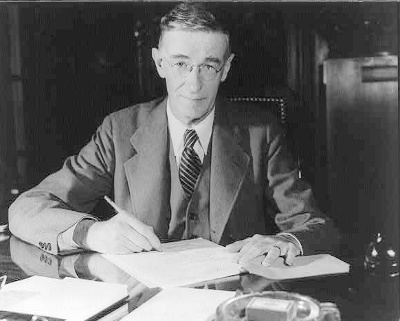| Tikalon Blog is now in archive mode.
An easily printed and saved version of this article, and a link
to a directory of all articles, can be found below: |
|
This article |
| Directory of all articles |
Basic Research
October 22, 2010
Several years ago I found the book, "The Endless Frontier: Vannevar Bush, Engineer of the American Century," by G. Pascal Zachary in a used bookstore.[1] I was delighted to pay just $6.00
vs the $32.50 original price, but the book would have been well worth the higher price. Zachary, who wrote for
The Wall Street Journal from 1989 - 2001, and then wrote the "Ping" column on innovation for a short stretch for
The New York Times, has written a scholarly and enjoyable biography of one of America's most important, but lesser known,
engineers,
Vannevar Bush.[2] Bush started as a professor at
MIT, was a co-founder of
Raytheon, and most importantly, Director of the
Office of Scientific Research and Development during
World War II. His legacy is so hidden that I was surprised to find that he had an important involvement in the
Manhattan Project, something that should have been quite evident from his position in the government during the war.

Vannevar Bush.
The first question on my mind when I read the book is likely the same as yours. How do you get a name like Vannevar? Bush was named to honor his father's friend whose last name was Vannevar. The most important aspect of Bush's career happened at war's end in 1945. It was then that he authored two important essays. The first, "
Science, The Endless Frontier," helped to channel the government's newfound love of technology into funding for university research and the creation of the
National Science Foundation.[3] The second, "
As We May Think," published in
The Atlantic Monthly, contained the idea of automated information retrieval.[4] Bush's information appliance, called
Memex, seems crude since it was implemented in the technology of the day, before the invention of the transistor and before ubiquitous computing, but it was a
hypertext system. Bush realized through his own work that innovation is fueled by data and the connections that exist between data sources. I use a modern information appliance every time I use the Internet, and it's certainly enhanced my life.
This year is the 65th anniversary of "The Endless Frontier," and many people are reflecting on its legacy. For example, a recent article in
Nature looked at the popularity of the term, "
basic research," over the years.[3] In a nice example of
data mining,
Roger Pielke, Jr., of the
Center for Science and Technology Policy Research of the
University of Colorado at Boulder looked at the number of articles in The New York Times that mentioned "basic research," and he plotted the number as a function of year.[5] I repeated his data mining exercise with the result shown in the figure.[6]

Number of New York Times articles mentioning basic research.
(Click for PDF datafile)
Not surprisingly, interest in basic research peaked quite suddenly after it was realized that technology derived from what had been very basic research had won the war. There was, of course, the
atomic bomb; but there were also
radar and other,
lesser known technologies. This dragged interest in basic research onto a higher, but still modest, plateau until
Sputnik was launched. The "
missle gap," the supposed disparity of missile technology between the
United States and the
Soviet Union, drove interest in research to new heights. Since the root cause of this gap was perceived to be a lack of capable scientists and engineers in the US, the government funded education programs that encouraged
baby boomers like me to choose a career in science.[7]
As can be seen from the curve, even in today's environment where research on
energy sources and mitigation strategies for
global warming should be considered essential, basic research seems to be in retreat. Pielke thinks that at least some of this retreat is from scientists deciding not to use that particular expression to define their work.[5] They're afraid of being dismissed as
ivory tower types and losing their funding. As history has shown, especially in the case of atomic energy, what appears to be absurdly abstract basic science can become extremely important in just the course of a few decades.

A figure from Vannevar Bush's first patent (US Patent No. 1,048,649, "Profile Tracer," December 31, 1912).
References:
- G. Pascal Zachary, "The Endless Frontier: Vannevar Bush, Engineer of the American Century," (Free Press, January 1997).
- G. Pascal Zachary, Biographical Notes.
- Science, The Endless Frontier, A Report to the President by Vannevar Bush, Director of the Office of Scientific Research and Development, July 1945, (United States Government Printing Office, Washington: 1945).
- Vannevar Bush, "As We May Think," The Atlantic Monthly, July, 1945.
- Roger Pielke, Jr., "In Retrospect: Science - The Endless Frontier," Nature, vol. 466, no. 7309 (August 19, 2010), pp. 922f.
- PDF file of my data.
- This Blog, "Learning Physics," August 18, 2006.
Permanent Link to this article
Linked Keywords: The Wall Street Journal; The New York Times; engineers; Vannevar Bush; MIT; Raytheon; Office of Scientific Research and Development; World War II; Manhattan Project; Science, The Endless Frontier; National Science Foundation; As We May Think; The Atlantic Monthly; Memex; hypertext; Nature; basic research; data mining; Roger Pielke, Jr.; Center for Science and Technology Policy Research; University of Colorado at Boulder; atomic bomb; radar; technology during World War II; Sputnik; missle gap; United States; Soviet Union; baby boomers; energy sources; global warming; ivory tower; US Patent No. 1,048,649.